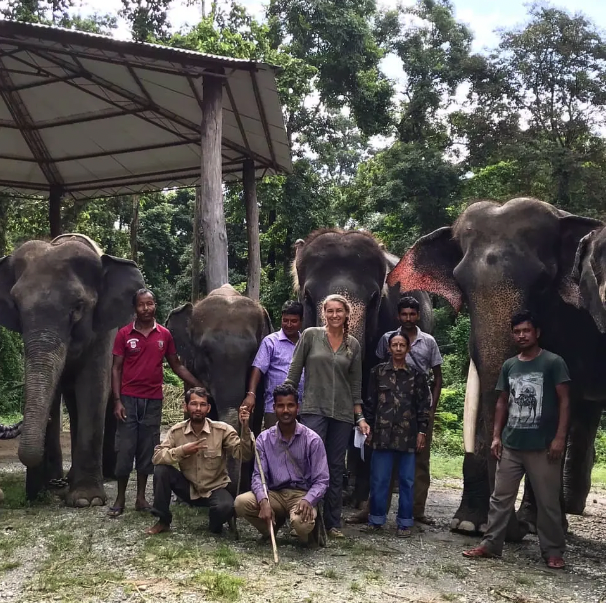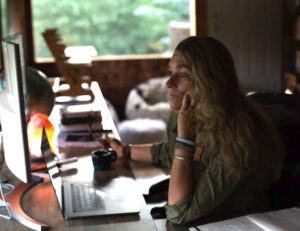
How the conflict between Asian elephants, Hindus in India, and Nepalese farmers speaks volumes about Valley life and beyond
By Eric Valentine

Every good movie has a plotline—that clear narrative wherein strong protagonists and antagonists have goals with obstacles to overcome; the stakes are high. Great movies—we like to call those ‘films’—also have something called subtext. Part metaphor, part simile, part irony, this nuanced but unmistakable storytelling element is the ‘But what’s it really about?’ factor involved in any interpersonal communication. It’s objectively critical, subjectively realized, and the difference between functional infotainment and crucial art.
So when you ask Kim Frank what her documentary on Himalayan elephants is about, the longtime Valley resident and writer can—with all seriousness—answer like this:
“You know, it’s not really about elephants …,” Frank said.
Cut to: Frank’s husband and an executive producer for the film, Dave Concannon, who just like his wife, is a Fellow with The Explorers Club. His years of planning and performing high-mountain climbs and deep-sea dives give him the logistical point of view about the film.
“For the past few years, Kim has been involved in a project to document the conflict between humans and elephants in remote northeast India, in the foothills of the Himalayas, hard up against the borders with Nepal, Bhutan and Tibet. She has published four articles internationally (see https://kimfrankwriter.com/), written a book titled Where the Forest Roars during the COVID lockdown, and she just returned to India to begin filming a documentary (also titled Where the Forest Roars) under the tutelage of Anthony Geffen, an occasional (Wood River Valley) resident who is David Attenborough’s producer,” Concannon said. He added, “This is just her recent work.”
Connecting Dots
So, what’s it really about?
The gestalt theory of perception attempts to explain how the human brain uses a key set of visual cues to interpret information and better understand relationships. It’s where the saying “the whole is greater than the sum of its parts” comes from. And the concept does nothing short of explain how humans place meaning on the things they see.
“I’m keenly interested in the space between humans and the wildlife we coexist with,” observed Frank who, in addition to her history degree, has earned two master’s degrees, one in social work and one in fine arts. “We’re so disconnected from our fragility.”
You’d think Frank was talking about her documentary and how the elephants of the Himalayas are, essentially, being pushed out of their indigenous habitat by Indian development and into Nepalese farmland where walls have been built to keep them from devouring crops and trampling homes and children on their exploration for food. That’s just the interspecies complications. Also at play is the intraspecies psychodrama between Indian Hindus who revere the elephant as sacred and the Nepalese people who don’t. In other words, one group of humans would kill an elephant as a last resort, and the other group would die for one. Meanwhile, all species involved have to eat.
How does all this connect with gestalt theory? Through Frank. Frank doesn’t necessarily see the world or its crises through an environmentalist lens. It’s not that she doesn’t get it. If you want her to, she can go on a tangent about elephant poop and its importance to the ecology of the forest which happens to produce the oxygen we breathe. Instead, Frank sees the world through that of her fields of study: history, social work, and art—a sort of perfect fit of studies to start a conversation that’s not about science-denial or science-only. Frank’s conversation is one of coexistence.
“We are literally at a point where elephants and humans are killing each other over water,” Frank remarked of the Himalayan conflict.
Seeing the connection between what’s happening alongside the Himalayas to what’s happening alongside the Sawtooths, Frank observed, “Here, maybe your favorite coffee shop closed down because they can’t find the labor. That seems like a First World problem, but it belies an actual infrastructure problem that has, at its roots, coexistence. Our inability as a community right now to have actual viable economic diversity and our inability to have viable places to live in this community; it is affecting our survival.”
Mile Markers
The mother of two adopted children from China, the wife of an exploration attorney and consultant who recovers shipwrecks and launches private space exploration projects, and the woman who was named a National Head Start fellow doesn’t shy away from uncharted territory. But creating, implementing and funding a feature film is entirely new ground for her.
By its nature, independent film production is a have-a-vision-first, get-a-gameplan-later endeavor. There’s no franchise recipe or sequel leveraging or even—in the case of documentaries—a final script to follow. Sometimes it feels like karma, not capital, drives the project’s destiny. Already Frank’s documentary has expanded past the one human-elephant confrontation that was the impetus for her wanting to make a film. But in documentary making there are things one could call mile markers—happy accidents, good advice, and moments of clarity that serve as signs you are on track, going the right way. And those are looking quite good right now.
Frank talked with us from San Francisco where she was meeting with a literary agent keen on representing her book. A producer for broadcaster, biologist, natural historian and author Sir David Attenborough is advising the production. The Explorers Club granted Frank the organizational flag to take on her travels, something only a small percentage of members (and an even smaller percentage of women members) get the privilege of carrying into the field. And Rolex, a brand whose history is embedded in mountaineering and exploration, outfitted her with an explorer’s watch to use during her travels.
All this makes it very realistic for an August 2023 goal date for having the documentary submission-ready for festivals. And if it’s ready by August 12, World Elephant Day, that would make it karmic, too.
